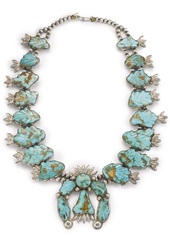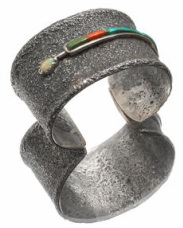|
If you have visited the Southwest, you have undoubtedly seen the abundance of silver and turquoise jewelry for sale. Walking around Santa Fe’s central plaza, you can still see Native Americans offering examples of the artistic traditions they have established over decades. Their work represents a uniquely American art form with a distinctive and beautiful sense of design and craftsmanship. The market for Indian jewelry was initially popularized by the advent of the railroads coming to the Southwest at the turn of the century, giving rise to stops operated by the successful Fred Harvey Company. From those roots in the tourist trade the market has expanded far beyond U.S. borders. Many of the top international auction houses feature regular (and extremely popular) sales of Native American jewelry and draw buyers and collectors from every corner of the globe. This past December at Bonhams Auctioneers, a Hopi bracelet by Charles Loloma (1921-1991) sold for $16,250, and in May at Sothebys, a Zuni silver and turquoise squash blossom necklace by Leekya Deyuse (Zuni, 1889-1966) sold for $23,750. While the strong market and increased interest in collecting Native American jewelry is relatively new, the Navajo, Zuni and other Pueblo tribes have been silversmithing and advancing their craft for over 150 years. What began as iron-working during the Navajo internment at Bosque Redondo (1863-1868) evolved into working with pounded silver ingots and the eventual inclusion of turquoise stones and modern techniques circa 1890. Most early pieces were not artist signed prior to the 1950's. As far as the tourists knew, it was 'Indian Made'. Recent scholarship and the cross-referencing of traders’ notes with museum collections has enabled us to ascribe authorship to many fine early pieces. With these attributions, several artists have risen above the rest of the market and become very desirable to collect. While there are several good books and vast information available on the internet regarding these topics, here are 5 tips for someone interested in starting their own collection of Native American jewelry. 1. Pick a genre to focus your collection: Perhaps you want to focus on a specific tribe such as Zuni or Navajo, or just bracelets or squash blossom necklaces. Another way to focus your collection is by choosing a time period. Generally the safest pieces to invest in were made between 1870 and 1945. In recent years, as I mentioned before, a few artists have drastically risen above the rest and a quick internet search can provide ample information to learn about some of these artists such as Charles Loloma, Kenneth Begay, and Preston Monongye. 2. Avoid mass produced pieces from the 1960s and 1970s that used less desirable stones and materials, such as the influx of Squash Blossom necklaces that were mass produced for tourist value with lower quality craftsmanship and artificially enhanced turquoise. 3. Beware of buying "Indian Style" jewelry. Whether you are at a store in the southwest or perusing eBay, you will definitely see many pieces that are "Indian style", and will not have much re-sale value. Instead, try to buy authentic pieces than can be attributed to a specific artist or tribe. As with any collection, it is best to buy from reputable dealers when possible. 4. Attend Santa Fe Indian Market. This annual show is a great place to learn, meet dealers, see a wide range of items, and get a better idea of pricing. And remember, like anything, there is room to bargain! 5. Do your own research. A visit to the Heard Museum or many other local museums with Native American collections can prove to be an excellent learning experience. Additionally, there is a rich library of books available on this subject. I would suggest starting with "Masters of Contemporary Indian Jewelry" by Nancy N. Schiffer, or any of the volumes of "American Indian Jewelry" by Dr. Gregory Schaaf. By following these few steps, you will be well on your way to a valuable (and wearable!) collection of beautiful and historical pieces of Native American jewelry. Happy collecting!  Silver and turquoise squash blossom necklace by Leekya Deyuse (Zuni, 1889-1966), sold for $23,750.  A Hopi bracelet by Charles Loloma (1921-1991), sold for $16,250. |
AuthorAppraiser and Fine Art Enthusiast Archives
February 2016
Categories
All
|
 RSS Feed
RSS Feed
